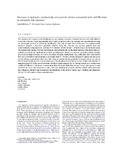Decrease in hydraulic conductivity in saturated soil columns and particle release associated with self-filtration in saturated soil columns

View/
Date
2008Author
Dikinya, O.
Hinz, C.
Aylmore, G.
Publisher
Elsevier http://www.linkinghub.elsevier.com/retrieve/pii/S0016706108001365Type
Published ArticleMetadata
Show full item recordAbstract
The dynamics of the process of self-filtration in soil columns have been evaluated for two soils with different
structural cohesion (Balkuling agricultural soil and a mining residue) by carrying out experiments focusing
on microscopic particle behaviour during filtration. Soil column experiments were set up to simultaneously
measure changes in hydraulic gradients (ΔH/ΔL) along the columns and outflow particle sizes and
concentrations during pressure leaching with solutions of 100, 10 and 1 mmol/L NaCl and deionised water.
The lowest ionic strength has resulted in more reduced hydraulic conductivity and relatively more release of
colloids associated with hydrodynamic shear and dispersion. Steady increases in hydraulic gradient (ΔH/ΔL)
and corresponding decreases in relative saturated hydraulic conductivity (K/Ko) with time were observed for
both soils and follow similar trends at all column depths. The most severe increases in ΔH/ΔL and decreases
in K/Ko always occurred near the inlet to the columns and the decline gradually decreased along the column.
The decrease in K/Ko and increase in ΔH/ΔL were clearly influenced by the size as well as the concentration of
migrating particles in the porous medium. The finer mobile particles in the mining residue were clearly more
readily self-filtered at the lower concentration than the larger Balkuling soil particles producing more rapid
increases in ΔH/ΔL and decreases in K/Ko. This was attributable to more effective self-filtration and more
pore clogging probably due to increased development of the diffuse double layer, swelling and dispersion
within the soil matrix at these concentrations.
